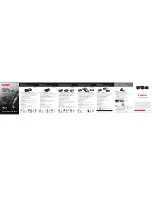
51
Operation
Connecting with RCP/MSU devices
The camera can be connected to an optional remote
control panel (RCP) or master setup unit (MSU) for
operation. For details about supported devices, contact
your Sony sales representative.
Configure the following settings on the CNS tab to
connect with an RCP/MSU.
Mode
Bridge:
Set to BRIDGE mode to connect directly with
an RCP on a LAN.
MCS:
Set to MCS mode when building a multi-
camera system on a LAN.
Master IP Address
Set the IP address of the master device when building a
multi-camera system on a LAN.
Camera No.
Set the camera number when building a multi-camera
system on a LAN. Set so that the number is not
duplicated within the system.
• Configure settings on the RCP/MSU side as required.
• An MSU is required in a multi-camera system.
• If there are multiple MSUs, set one MSU as the
master, and set all other MSUs as clients.
Outputting Tracking Data
The unit can output tracking data compliant with the
free-d protocol from the LAN connector to work with
various systems, such as virtual studio systems.
The tracking data is output using UDP packets in sync
with the external sync signal.
To output tracking data, configure the following settings
on the Tracking data output tab.
Enable
Insert a check mark to enable the output of tracking data.
Destination IP address
When Transfer mode is set to Always, specify the IP
address of the client which will receive the tracking data
from the camera.
UDP port number
When Transfer mode is set to Always, specify the UDP
port of the client which will receive the tracking data
from the camera.
When Transfer mode is set to On demand, specify the
UDP port number on which the camera will listen for
messages from the client.
Transfer mode
Set the output control method for the tracking data.
Always:
Always output tracking data.
On demand:
Start/stop output of tracking data in
accordance with a “Type D0 (poll/command)”
message from the client.
Camera ID
Set the ID for identifying the camera.
When Transfer mode is set to On demand, the unit
controls the output of tracking data using messages
specified by Type D0 commands of the free-d protocol.
The unit supports the following commands.
00 (Stop stream mode):
Stop output.
01 (Start stream mode):
Start output.
In addition, the tracking data output from the unit is
stored and output as shown below according to the
format specified by the Type D1 command of the free-d
protocol.
Camera ID:
Stores the configured camera ID.
Camera Pan Angle:
Stores the pan angle of the unit
in a format specified by the free-d protocol.
Camera Tilt Angle:
Stores the tilt angle of the unit in
a format specified by the free-d protocol.
Camera Roll Angle:
Not supported (always 0)
Camera X-Position:
Not supported (always 0)
Camera Y-Position:
Not supported (always 0)
Camera Height (Z-Position):
Not supported (always
0)
Camera Zoom:
Store the zoom position of the unit in
the same format as VISCA commands.
Camera Focus:
Store the focus position in the same
format as VISCA commands.
Spare/Undefined Data:
Stores the frame count from
the upper 4 bits (0h to Fh) and the iris value (F
Notes
Содержание BRC-H800
Страница 65: ...Sony Corporation ...















































